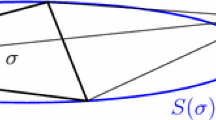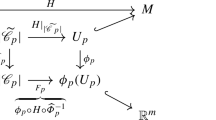Abstract
We consider a new construction, the weak Delaunay triangulation of a finite point set in a metric space, which contains as a subcomplex the traditional (strong) Delaunay triangulation. The two simplicial complexes turn out to be equal for point sets in Euclidean space, as well as in the (hemi)sphere, hyperbolic space, and certain other geometries. There are weighted and approximate versions of the weak and strong complexes in all these geometries, and we prove equality theorems in those cases also. On the other hand, for discrete metric spaces the weak and strong complexes are decidedly different. We give a short empirical demonstration that weak Delaunay complexes can lead to dramatically clean results in the problem of estimating the homology groups of a manifold represented by a finite point sample.
Similar content being viewed by others
References
Amenta, N., Bern, M.: Surface reconstruction by Voronoi filtering. Discrete Comput. Geom. 22, 481–504 (1999)
Amenta, N., Choi, S., Dey, T.K., Leekha, N.: A simple algorithm for homeomorphic surface reconstruction. Int. J. Comput. Geom. Appl. 12(1–2), 125–141 (2002)
Attali, D., Edelsbrunner, H., Harer, J., Mileyko, Y.: Parametrized witness complexes. In: Proceedings 10th Workshop on Algorithms and Data Structures (WADS), Lecture Notes in Computer Science, vol. 4619, pp. 386–397. Springer-Verlag (2007)
Attali, D., Edelsbrunner, H., Mileyko, Y.: Weak witnesses for Delaunay triangulations of submanifolds. In: SPM’07: Proceedings of the 2007 ACM Symposium on Solid and Physical Modeling, pp. 143–150, New York (2007)
Boissonnat, J.-D., Guibas, L.J., Oudot, S.Y.: Manifold reconstruction in arbitrary dimensions using witness complexes. In: Proceedings 23rd ACM Symposium on Computational Geomentry, (2007)
Chazal, F., Oudot, S.Y.: Towards persistence-based reconstruction in Euclidean spaces. In: Proce. 24th ACM Sympos. Comput. Geom. (2008, to appear).
Chazal, F., Cohen-Steiner, D., Lieutier, A.: A sampling theory for compact sets in Euclidean space. In: SoCG ’06: Proceedings of the 22nd Annual Symposium on Computational Geometry, pp. 319–326. ACM Press, New York (2006)
Chazal, F., Lieutier, A.: Stability and computation of topological invariants of solids in R n. Discrete Comput. Geom. 37(4), 601–617 (2007)
Cheng, S.-W., Dey, T.K., Ramos, E.: Manifold reconstruction from point samples. In: Proceedings of the 16th Annual ACM-SIAM Symposium on Discrete Algorithms, pp. 1018–1027 (2005)
Cohen-Steiner, D., Edelsbrunner, H., Harer, J.: Stability of persistence diagrams. Discrete Comput. Geom. 37(1), 103–120 (2007)
de Silva, V., Carlsson, G.: Topological estimation using witness complexes. In: Alexa, M., Rusinkiewicz, S. (eds.) Eurographics Symposium on Point-Based Graphics, ETH, Zürich, Switzerland (2004)
Edelsbrunner, H.: The union of balls and its dual shape. Discrete Comput. Geom. 13(3–4), 415–440 (1995)
Edelsbrunner, H., Letscher, D., Zomorodian, A.: Topological persistence and simplification. Discrete Comput. Geom. 28, 511–533 (2002)
Edelsbrunner, H., Mücke, E.P.: Three-dimensional alpha shapes. ACM Trans. Graph. 13(1), 43–72 (1994)
Edelsbrunner, H., Shah, N.R.: Triangulating topological spaces. Int. J. Comput. Geom. Appl. 7(4), 365–378 (1997)
Hatcher, A.: Algebraic Topology. Cambridge University Press, Cambridge (2002)
Leibon, G., Letscher, D.: Delaunay triangulations and Voronoi diagrams for Riemannian manifolds. In: SCG’00: Proceedings of the Sixteenth Annual Symposium on Computational Geometry, pp. 341–349. ACM Press, New York (2000)
Martinetz, T., Schulten, K.: Topology representing networks. Neural Netw. 7(3), 507–522 (1994)
Motzkin, T.S.: Beiträge zur Theorie der linearen Ungleichungen. PhD thesis, University of Basel (1933)
Motzkin, T.S.: Two consequences of the transposition theorem on linear inequalities. Econometrika 19, 184–185 (1951)
Niyogi, P., Smale, S., Weinberger, S.: Finding the homology of submanifolds with high confidence from random samples. Discrete Comput. Geom. 39, 419–441 (2008)
Oudot, S.Y.: On the topology of the restricted Delaunay triangulation and witness complex in higher dimensions. Manuscript, preprint available at http://graphics.stanford.edu/projects/lgl/papers/o-trdwchd-06/o-trdwchd-06.pdf, November 2006.
Preparata, F.P., Shamos, M.I.: Computational Geometry: An Introduction. Springer Verlag, New York (1985)
Sugihara, K.: Laguerre voronoi diagram on the sphere. J. Geom. Graph. 6(1), 69–81 (2002)
Zomorodian, A., Carlsson, G.: Computing persistent homology. Discrete Comput. Geom. 33(2), 249–274 (2005)
Author information
Authors and Affiliations
Corresponding author
Rights and permissions
About this article
Cite this article
de Silva, V. A weak characterisation of the Delaunay triangulation. Geom Dedicata 135, 39–64 (2008). https://doi.org/10.1007/s10711-008-9261-1
Received:
Accepted:
Published:
Issue Date:
DOI: https://doi.org/10.1007/s10711-008-9261-1
Keywords
- Delaunay triangulation
- Voronoi diagram
- Laguerre diagram
- Witness complex
- Manifold reconstruction
- Topological approximation




